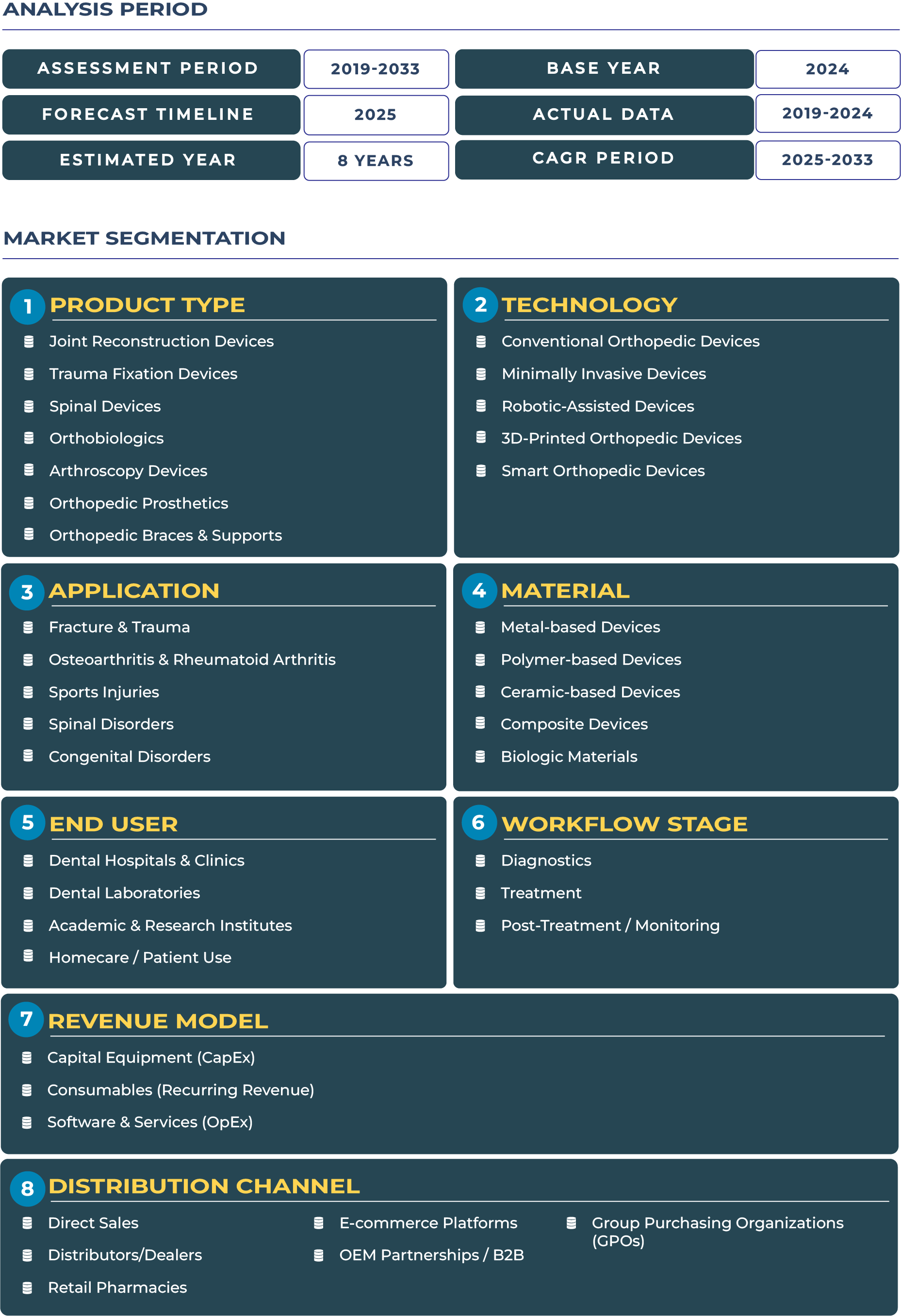Report Format:
![]()
![]() |
Pages: 110+
|
Pages: 110+
Nigeria Orthopedic Devices Market Outlook: Nigeria’s Unmet Orthopedic Needs Amid Population Growth Fueling Market Expansion
Nigeria orthopedic devices market is at a pivotal juncture, reflecting the dual realities of significant unmet medical needs and rapid population growth. With more than 220 million citizens, the country faces a unique demographic challenge: a large youth base with increasing urbanization, combined with an older population at risk of musculoskeletal disorders. Limited orthopedic infrastructure has resulted in many patients relying on imports or traveling abroad for care. In this context, the orthopedic devices ecosystem in Nigeria is becoming increasingly important as policymakers, hospitals, and manufacturers address the gaps in trauma care, joint reconstruction, and spinal device accessibility.
By 2025, Nigeria orthopedic devices industry is estimated to reach USD 153.9 million, with projections indicating growth to USD 365.1 million by 2033, advancing at a CAGR of 11.4% during 2025–2033. This growth trajectory is supported by urban hospital expansions, the rising incidence of trauma injuries from road accidents, and increased demand for orthopedic prosthetics. However, affordability and availability remain critical factors shaping adoption across regions. As Nigeria strengthens its health infrastructure, the orthopedic devices landscape is expected to mature, offering new opportunities for international and domestic manufacturers.
Orthopedic Devices Industry in Nigeria Positioned for Double-Digit Growth
The Nigeria orthopedic devices market is expanding steadily, propelled by demographic shifts and structural healthcare reforms. A key driver is the country’s large and young population, where urbanization has accelerated demand for advanced medical services. Road traffic accidents, a significant cause of musculoskeletal trauma, highlight the urgent need for trauma fixation devices across public and private hospitals. Moreover, joint replacement and spinal care procedures are gaining traction in Lagos and Abuja, fueled by medical tourism and improved access to surgical expertise. Despite challenges, the orthopedic devices sector is increasingly seen as a strategic healthcare investment area, particularly with Nigeria’s economic diversification efforts beyond oil.
Growth in this ecosystem also aligns with Nigeria’s ambition to strengthen its healthcare system under the Federal Ministry of Health, which continues to prioritize access to essential medical technologies. Manufacturers focusing on low-cost implant ranges and orthobiologics are well-positioned to capture long-term demand in a market that is still significantly underpenetrated.
Drivers and Restraints: Uncovering the Forces Shaping Nigeria orthopedic devices Sector
Population-driven demand and hospital growth are reshaping orthopedic care delivery in Nigeria. With urban centers like Lagos, Abuja, and Port Harcourt experiencing rapid healthcare investment, orthopedic care is becoming a focal point of hospital expansion projects. Trauma from road accidents remains a critical driver, making trauma fixation devices indispensable in emergency units. Orthopedic prosthetics are also increasingly in demand, particularly for patients suffering from congenital deformities or amputations linked to conflict-related injuries. These factors, combined with donor-led orthopedic outreach programs, are catalyzing growth in Nigeria orthopedic devices industry.
However, structural restraints continue to hinder market penetration. Weak public funding mechanisms mean that most orthopedic procedures are paid out-of-pocket, limiting accessibility for low- and middle-income patients. Security challenges in northern states disrupt supply chains, while underdeveloped rural healthcare infrastructure restricts penetration of advanced devices. Logistics issues, coupled with low awareness of advanced orthopedic treatments, further impede growth. Despite these barriers, private sector players are increasingly stepping in to fill the gap through urban hubs and mobile outreach services.
Trends and Opportunities: Where Nigeria orthopedic devices Landscape is Heading
Private sector expansion in major cities is creating new benchmarks in orthopedic care. Lagos and Abuja are witnessing the growth of multi-specialty hospitals equipped with modern surgical capabilities, including arthroscopy and spinal surgery suites. Training partnerships with international institutions are also improving local surgical expertise, helping Nigerian hospitals to retain patients who might otherwise travel abroad for procedures. Furthermore, donor-driven initiatives are enabling access to low-cost orthopedic implants and consumables, addressing affordability gaps in underserved communities.
Emerging opportunities lie in city-centric hubs and cost-effective solutions. Lagos and Abuja are set to become strategic centers for orthopedic device distribution and surgical training, mitigating risks associated with logistics and insecurity. Low-cost implant ranges, designed for affordability without compromising quality, are expected to gain traction among mid-tier hospitals. Additionally, mobile surgical outreach programs are proving effective in expanding access beyond urban centers, particularly in regions where fixed orthopedic infrastructure is limited. These opportunities underscore the potential for innovation-driven growth in Nigeria orthopedic devices landscape.
Competitive Landscape: Global and Local Players Redefining Nigeria orthopedic devices Market
Nigeria orthopedic devices sector is drawing attention from both multinational corporations and domestic players. Companies such as Johnson & Johnson MedTech are recognized for supplying joint reconstruction and trauma fixation solutions in Nigerian hospitals. Local distributors are also playing a critical role in expanding access, particularly in underserved states. The market is witnessing a shift toward establishing city-based hubs in Lagos and Abuja, which allow companies to centralize inventory, streamline logistics, and respond quickly to trauma care needs.
Collaborations with teaching hospitals, as well as partnerships with orthopedic associations like the Nigerian Orthopaedic Association, are driving awareness and skill development. Strategies such as mobile outreach clinics are not only enhancing patient trust but also extending brand visibility into remote regions. The Nigeria orthopedic devices ecosystem is thus evolving into a hybrid model, where international expertise converges with local distribution efficiency to meet the country’s rising healthcare demands.







